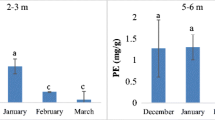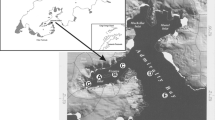Abstract
Algae biomass and community structure can reflect the current situation of a lake, especially in response to changes in light intensity. The relationship between chlorophyll a (Chl a) and chlorophyll b (Chl b) ratio and the proportion of Chlorophyta within the algae community were analyzed in this study. Results showed that light was more intense in August than in March. Algae density in August was greater than in March. The concentration of Chl a and b was influenced by light intensity level. In March, Microcystis and Kirchneriella sp dominated surface water, where the light intensity was over 216 μmol m−2 s−1, Gloeocapsa, Dictyospaerium pulchellum, and Scenedesmus dominated intermediate water, where the light ranged from 36 to 216 μmol m−2 s−1. Asterionella formosa Hassall and Mougeotia scalaris dominated near the bottom, where the light was below 36 μmol m−2 s−1. In August, Microcystis and Selenastrum reinsch dominated surface water, where the light was above 18 μmol m−2 s−1. Chroococcus, Chlorella, and Scendesmus quadricauda dominated intermediate water, where light ranged from 90 to 180 μmol m−2 s−1. Anabaena spirioides and Pediastrum simplex dominated bottom water, where the light was below 90 μmol m−2 s−1. According to the mean value of Chlorophyta density and algae cell density in three different water levels, the ratio of Chlorophyta and algae community declined from March to August, ranging from 12.35–21.41 to 4.28–11.19 %. The mean value ratio of Chl b and Chl a in three different water levels showed the same tendency from March to August, ranging from 18.05–21.77 to 15.15–17.44 %. These variations in chlorophyll ratio and Chlorophyta ratio indicated that the structure of the algae community structure was influenced by differences in light intensity.







Similar content being viewed by others
References
Ali K, Witter D, Ortiz J (2014) Application of empirical and semi-analytical algorithms to MERIS data for estimating chlorophyll a in Case 2 waters of Lake Erie. Environ Earth Sci 71:4209–4220. doi:10.1007/s12665-013-2814-0
Bowes MJ, Gozzard E, Johnson AC, Scarlett PM, Roberts C, Read DS, Armstrong LK, Harman SA, Wickham HD (2012) Spatial and temporal changes in chlorophyll-a concentrations in the River Thames basin, OK: are phosphorus concentrations beginning to limit phytoplankton biomass? Sci Total Environ 426:45–55. doi:10.1016/j.scitotenv.2012.02.056
Cai Y, Kong F, Shi L, Yu Y (2012) Spatial heterogeneity of cyanobacterial communities and genetic variation of Microcystis populations within large, shallow eutrophic lakes (Lake Taihu and Lake Chaohu, China). J Environ Sci 24:1832–1842. doi:10.1016/S1001-0742(11)61007-3
Chen H, Shen S, Liang Y, Leng J, Tang M, Gong Y (2005) Evidence for dissociation of chlorophyll b from the main light-harvesting complex in the oligomerization state isolated from marine alga, Bryopsis corticulans. Biochim Biophys Acta 1707:170–178. doi:10.1016/j.bbabio.2004.12.001
Chen J, Quan WT, Wen ZH, Cui TW (2014) An improved three-band semi-analytical algorithm for estimating chlorophyll-a concentration in highly turbid coastal waters: a case study of the Yellow River estuary, China. Environ Earth Sci 69:2709–2719. doi:10.1007/s12665-012-2093-1
Cloot A (1994) Effect of light intensity variations on the rate of photosynthesis of algae: a dynamical approach. Math Comput Model 19:23–33. doi:10.1016/0895-7177(94)90038-8
Deblois CP, Dufresne K, Juneau P (2012) Response to variable light intensity in photoacclimated algae and cyanobacteria exposed to atrazine. Aquat Toxicol 126:77–84. doi:10.1016/j.aquatox.2012.09.005
Eads DD, Castner EW, Alberte RS, Mets L, Fleming GRJ (1989) Direct observation of energy transfer in a photosynthetic membrane: chlorophyll b to chlorophyll a transfer in LHC. J Phys Chem 93:8271–8275
EI-Shaarawi A, Munawar M (1978) Statistical Evaluation of the Relationships Between Phytoplankton Biomass, Chlorophyll a, and Primary Production in Lake Superior. J Gt Lakes Res 4(3–4):443–455. doi:10.1016/S0380-1330(78)72213-6
Elizabeth J (1997) Methods for the determination of chemical substances in marine and estuarine environmental matrices, 2nd Edn. Method 446.0
Eullaffroy P, Vernet G (2003) The F684/F735 chlorophyll fluorescence ratio: a potential tool for rapid detection and determination of herbicide phytotoxicity inalgae. Water Res 37:1983–1990. doi:10.1016/S0043-1354(02)00621-8
Garmendia M, Borja A, France J, Revilla M (2013) Phytoplankton composition indicators for the assessment of eutrophication in marine waters: present state and challenges within the European directives. Mar Pollut Bull 66:7–16. doi:10.1016/j.marpolbul.2012.10.005
Gorai T, Katayama T, Obata M, Murata A, Taguchi S (2014) Low blue light enhances growth rate, light absorption, and photosynthetic characteristics of four marine phytoplankton species. J Exp Mar Biol Ecol 459:87–95. doi:10.1016/j.jembe.2014.05.013
Huang CC, Li YM, Yang H, Sun DY, Yu ZY et al (2014) Detection of algal bloom and factors influencing its formation in Taihu Lake from 2000 to 2011 by MODIS. Environ Earth Sci 71:3705–3714. doi:10.1007/s12665-013-2764-6
Huisman J, Sommeijer BP (2002) Population dynamics of sinking phytoplankton in light-limited environments: simulation techniques and critical parameters. J Sea Res 48:83–96. doi:10.1016/S1385-1101(02)00137-5
Huisman J, Weissing FJ (1994) Light-limited growth and competition for light in well-mixed aquatic environments: an elementary model. Ecology 75:507–520
Huisman J, Weissing FJ (1995) Competition for nutrients and light in a mixed water column: a theoretical analysis. Water Sci Technol 32:143–147. doi:10.1016/0273-1223(95)00691-5
Huisman J, Jonker JR, Zonneveld C, Weissing FJ (1999) Competition for light between phytoplankton species: experimental tests of mechanistic theory. Ecology 80:211–222
Huo SL, Xi BD, Su J, He ZS, Zan FY, Yu H (2014) Defining physico-chemical variables, chlorophyll-a and Secchi depth reference conditions in northeast eco-region lakes, China. Environ Earth Sci 71:995–1005. doi:10.1007/s12665-013-2656-9
Kasprzak P, Padisak J, Koschel R, Krienitz L, Gervais F (2008) Chlorophyll a concentration across a trophic gradient of lakes: an estimator of phytoplankton biomass? Limnologica 38:327–338. doi:10.1016/j.limno.2008.07.002
Leonardos N, Richard JG (2004) Responses of elemental and biochemical composition of Chaetoceros muelleri to growth under varying light and nitrate:phosphate supply ratios and their influence on critical N : P. Limnol Oceanogr 49(6):2105–2114. doi:10.4319/lo.2004.49.6.2105
Li Y, Zhou W, Hu B, Min M, Chen P, Ruan RR (2012) Effect of light intensity on algal biomass accumulation and biodiesel production for mixtrophic strains Chlorella kessleri and Chlorella protothecoide cultivated in highly concentrated municipal wastewater. Biotechnol Bioeng. doi:10.1002/bit.24491
Lorenzen C (1967) Determination of chlorophyll and pheopigments:spectrophotometric equations. Limnol Oceanogr 12(2):343–346. doi:10.4319/lo.1967.12.2.0343
Nakayama K, Mimuro M (1994) Chlorophyll forms and excitation energy transfer pathways in light-harvesting chlorophyll a/b-protein complexes isolated from the siphonous green alga, Bryopsis maxima. Bioenergetics 1184:103–110. doi:10.1016/0005-2728(94)90159-7
Palsson LO, Spangfort MD, Gulbinas V, Gillbro T (1994) Ultrafast chlorophyll b–chlorophyll a excitation energy transfer in the isolated light harvesting complex, LHC II, of green plants. Implications for the organisation of chlorophylls. FEBS Lett 339:134–138. doi:10.1016/0014-5793(94)80400-1
Paresys G, Rigart C, Rousseau B, Wong AWM, Fan F, Barbier JP, Lavaud J (2005) Quantitative and qualitative evaluation of phytoplankton communities by trichromatic chlorophyll fluorescence excitation with special focus on cyanobacteria. Water Res 39(5):911–921. doi:10.1016/j.watres.2004.12.005
Pham Thi NN, Huisman J, Sommeijer BP (2005) Simulation of three-dimensional phytoplankton dynamics: competition in light-limited environments. J Comput Appl Math 174:57–77. doi:10.1016/j.cam.2004.03.023
Powell TM, Richerson PJ, Dillon TM, Agee BA, Dozier BJ, Godden AD, Myrup OL (1975) Spatial scales of current speed and phytoplankton biomass fluctuations in lake Tahoe. Science (Washington, DC) 189:1088–1089. doi:10.1126/science.189.4208.1088
Richardson TL, Lawrenx E, Pinckney JL, Guajardo RC, Walker EA, Paerl HW, Maclntyre HL (2010) Spectral fluorometric characterization of phytoplankton community composition using the Algae Online Analyser. Water Res 44:2461–2472. doi:10.1016/j.watres.2010.01.012
Sabater S, Artigas J, Duran C, Pardos M, Romani AM, Tornes E, Ylla I (2008) Longitudinal development of chlorophyll and phytoplankton assemblages in a regulated large river (the Ebro River). Sci Total Environ 404:196–206. doi:10.1016/j.scitotenv.2008.06.013
Sand JK, Borum J (1991) Interactions among phytoplankton, periphyton, and macrophytes in temperate freshwaters and estuaries. Aquat Bot 41:137–175. doi:10.1016/0304-3770(91)90042-4
Shen PP, Shi Q, Hua ZQ, Kong FX, Wang ZG, Zhuang SX, Chen DC (2003) Analysis of microcystins in cyanobacteria blooms and surface water samples from Meiliang Bay, Taihu Lake, China. Environ Int 29:641–647. doi:10.1016/S0160-4120(03)00047-3
Sherrard NL, Nimmo M, Llewellyn CA (2006) Combining HPLC pigment markers and ecological similarity indices to assess phytoplankton community structure: an environmental tool for eutrophication? Sci Total Environ 361:97–110. doi:10.1016/j.scitotenv.2005.08.058
Wei Z, Zhang L, Yang S, Lv X, Zhu J, Dou J (2012) Community structure and seasonal succession of Phytoplankton in Erhai Lake. J Hydroecology 1674-3075:04-0021-05
Wen H, Ma G (2011) Study of Water Quality and Algae in Erhai Lake during 2008-2010. Environ Sci Manag 1674-6139 11-0044-05
Winslow KP, Francoeur SM, Peacor SD (2014) The influence of light and nutrients on benthic filamentous algal growth: a case study of Saginaw Bay, Lake Huron. J Gt Lakes Res 40:64–74. doi:10.1016/j.jglr.2014.01.012
Wu Q, Wang Y (1999) On the succession of aquatic communities in Erhai Lake. J Lake Sci 11(3):273–281
Wyman M, Fay P (1986) Underwater light climate and the growth and pigmentation of blue-green algae (Cyanobacteria) II. The influence of light quality. Proc R Soc Lond Ser B Biol Sci 227:367–380. doi:10.1098/rspb.1986.0027
Xu ZG, Wu HY, Zhan DM, Sun FX, Sun JZ, Wang GC (2014) Combined effects of light intensity and NH4+-enrichment on growth, pigmentation, and photosynthetic performance of Ulva prolifera (Chlorophyta). Chin J Oceanol Limnol. doi:10.1080/02705060.2008.9664215
Yang SW, Jin XC (2008) Critical light intensities for Microcystis aeruginosa, Scenedesmus quadricauda and Cyclotella sp. and competitive growth patterns under different light:N: P ratios. J Freshw Ecol 23(3):387–396. doi:10.1080/02705060.2008.9664215
Yu H (2009) Study on Correlation between Chlorophyll a and Algal Density of Biological Monitoring. Environ Monit China 1002-6002:06-0040-03
Zhou Q, Chen W, Shan K, Zheng L, Song L (2014) Influence of sunlight on the proliferation of cyanobacterial blooms and its potential applications in Lake Taihu, China. J Environ Sci 26:626–635. doi:10.1016/S1001-0742(13)60457-X
Acknowledgment
The study was financially supported by the Grand State Special Project of Water Pollution Control and Treatment (2012ZX07102).
Conflict of interest
The authors declare that they have no commercial or associative interest that represents a conflict of interest in connection with the work submitted.
Author information
Authors and Affiliations
Corresponding author
Rights and permissions
About this article
Cite this article
Yang, S., Jin, W., Wang, S. et al. Chlorophyll ratio analysis of the responses of algae communities to light intensity in spring and summer in Lake Erhai. Environ Earth Sci 74, 3877–3885 (2015). https://doi.org/10.1007/s12665-015-4140-1
Received:
Accepted:
Published:
Issue Date:
DOI: https://doi.org/10.1007/s12665-015-4140-1




